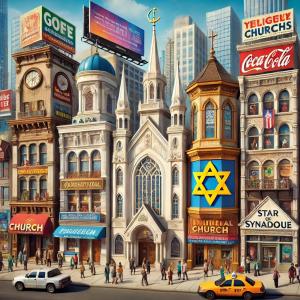
As you meander through the bustling urban centers and serene suburbs, a striking sight unfolds: a landscape peppered with churches, each proudly perched in its own little niche. This dense constellation of religious establishments prompts a whimsical yet poignant exploration: Why are these sanctuaries as prolific as coffee shops in a gentrified neighborhood? Is there a spiritual Starbucks effect at play here? This exploration seeks to uncover the deeper, often humorous realities behind this ecclesiastical explosion and its implications for the communities bedecked with belfries and crosses.
The Multiplicity of Churches
Historical Hangover
The church’s omnipresence isn’t merely a reflection of modern spiritual zeal but a lingering aftereffect of historical dominance. For centuries, Christianity held the monopoly on Western spirituality, much like a divine conglomerate, weaving its doctrines into the fabric of societies and establishing outposts across the landscapes. This has resulted in a dizzying array of denominations, each rooted in a slightly different interpretation of scripture and tradition, proliferating across time like a divine multiverse, each universe claiming its own path to salvation.
Denominational Diversification
The denominational landscape is akin to an all-you-can-eat buffet, where every dish vies for the title of the “true” sustenance. From the high-church pageantry of the Anglicans to the fire-and-brimstone simplicity of the Evangelicals, each flavor of Christianity insists on its exclusive culinary excellence. This results in a rich tapestry of faith communities, where a Lutheran church might stoically face a charismatic Pentecostal temple across the same street, each convinced of its singular recipe for eternal life, fostering diversity but complicating unity.
Proximity and Competition
Divine Market Dynamics
Like businesses clamoring for prime real estate, churches strategically settle in locations teeming with potential parishioners. This ecclesiastical land rush is driven by a sacred market logic—positioning oneself close to the faithful ensures higher foot traffic and, ideally, a fuller pews. It’s a holy competition, echoing the commercial tactics of retail giants, each church positioning itself as the go-to destination for all spiritual needs, from baptismal services to marital blessings, all conveniently located just around the corner.
Theological Non-collaborators
Despite their geographical closeness, doctrinal differences often keep churches at a polite arm’s length from one another. Collaboration is as scarce as humility at a clergy convention, with each congregation clinging to its divine directive like a moral compass. This results in a landscape where shared missions are rare and theological territories distinctly marked, making the religious map as fragmented as a shattered stained-glass window.
Socioeconomic Divine Interventions
Sanctuaries or Sinkholes?
In areas where economic despair meets urban decay, churches frequently sprout up, providing beacons of hope and community engagement. These institutions offer more than just spiritual solace; they become crucial centers for social welfare, offering everything from food pantries to job training workshops. However, the proliferation of these spiritual centers in financially depleted areas also raises questions about their economic impact. Are they catalysts for community development, or do they inadvertently contribute to a cycle of dependency and resource drainage?
Ego in the Altars
One might wonder whether the proliferation of churches is driven by divine inspiration or human ambition. The urge to erect new churches often seems fueled by personal legacy rather than communal need, with pastors keen to build their own kingdoms of faith. This can lead to a spiritual landscape dotted with personal fiefdoms, where the shepherd’s prominence may overshadow the flock’s welfare, turning sacred missions into displays of clerical clout.
Capitalism vs. Socialism: Ecclesiastical Economics
Divine Dollar Debate
The economic models underpinning church operations spark a lively debate: Should churches operate like capitalist corporations or embrace a socialist ethos? In a capitalist framework, churches compete for souls as businesses do for customers, emphasizing growth, expansion, and market dominance. Conversely, a socialist approach would advocate for pooling resources, centralizing outreach programs, and focusing on communal rather than denominational success, fostering a more collaborative religious environment.
Religious Real Estate: Churches vs. Mosques and Synagogues
A Tale of Many Temples
While churches seem to spring up with the ubiquity of fast-food outlets, mosques and synagogues take a more conservative approach to expansion, reflecting broader demographic, cultural, and theological dynamics. Unlike the Christian franchise model, these religious institutions often serve larger, more consolidated communities, necessitating fewer physical locations but larger gathering spaces. This contrast highlights differing organizational and community engagement strategies, with mosques and synagogues prioritizing communal unity over territorial expansion, leading to a less crowded but potentially more cohesive community fabric.
Wrap-Up
This whimsical jaunt through our sacred spaces reveals a complex interplay of historical inertia, market dynamics, and ecclesiastical ambitions. The ubiquitous church on every corner not only offers a testament to religious freedom and diversity but also poses challenges for community cohesion and resource allocation. As we contemplate the future of these spiritual institutions, perhaps a new narrative will emerge—one that harmonizes the need for both divine guidance and community pragmatism, turning our crowded religious landscapes into harmonious havens of hope and human connection.
These are my thoughts…what do you think? I look forward to reading your perspective!
Derrick Day is the author of Deconstructing Religion, Deconstructing Religion 2, The Martial Leader, MetaSpeech, and the host of The Forward Podcast.
Follow him on Facebook, Instagram, TikTok, and YouTube









